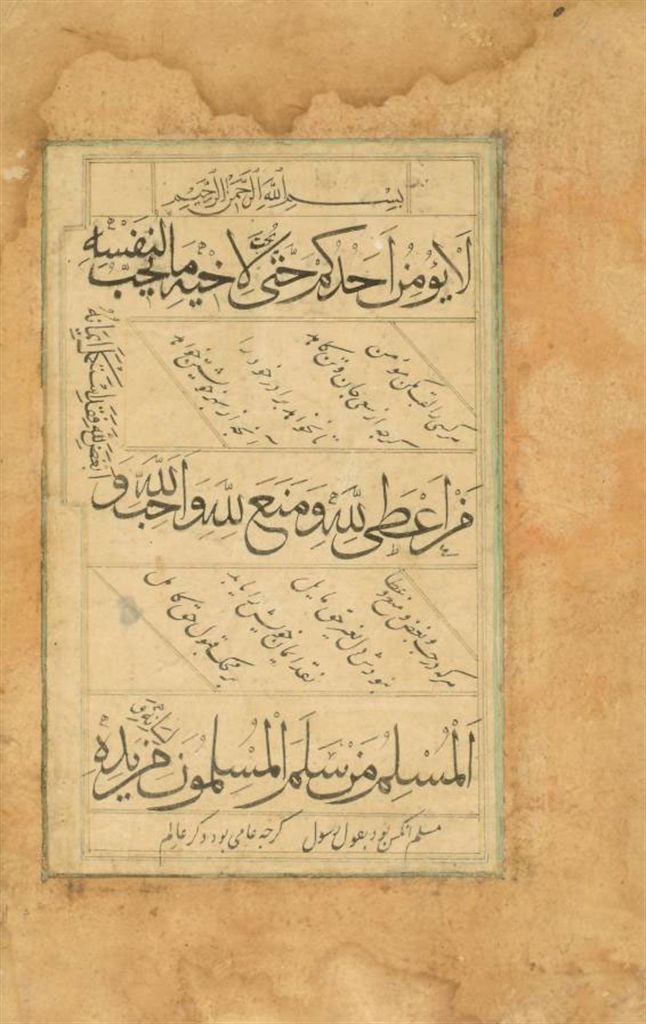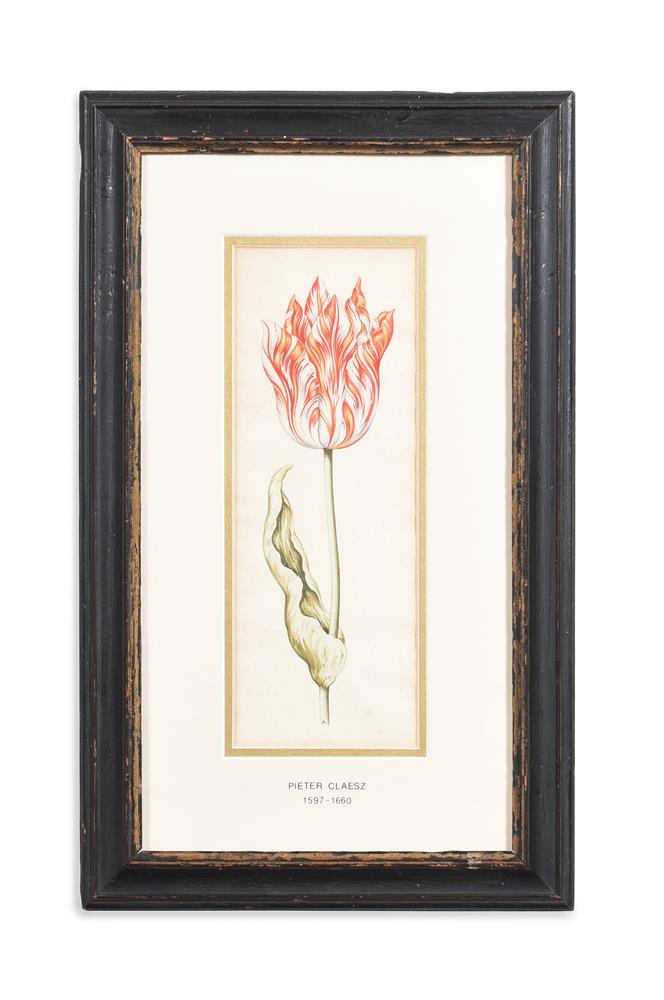Tulip Album A Manuscript Album containing 53 watercolour drawings of Tulips. [English or Dutch: mid 17th century]. Small 2° (310 x 190mm). 53 watercolour drawings on paper, some heightened in white and gum arabic, the first 14 tulips drawn directly into the album, the balance pasted in, 38 blank leaves, one leaf with a tulip drawing in ink. Foliated in a later hand, names in English on folios 16-20, 29, 34a, 36-37, 39-40, 42-47 and others in Dutch. 17th century sheep (neatly rebacked and cornered to style), contained in a modern green straight-grained morocco solander box. Provenance : "May 11 1666 in this book is sixte and 5:tulipes drawne to the life" (inscription on folio 16); Joseph Johnson (bookseller and publisher, signature 1794); Hannibal Jones (signature 1812); Doctor Turton (pencilled signature); Hertzberger, Amsterdam (sold 2 June 1953, lot 235, possibly to:); J.M.C. Hoog. A RARE SEVENTEENTH-CENTURY ILLUSTRATED RECORD OF TULIPOMANIA IN ENGLAND. This very fine album is important both for the beauty of the botanical watercolours and also as a record of the names and appearance of many of the long-vanished varieties of tulips that generated such passion in 17th-century Europe. The album was either compiled in England or sent to England at an early date. An inscription in English dated 1666 states that the tulips were "drawne to life", and half of the tulips have English names, written in an English hand. The album bears witness to the trans-European nature of the interest in tulips and to the flourishing trade in tulips between Holland and England that existed at that time: many of the drawings are pasted into the album, and it is possible that they were executed as exemplars in Holland and then sent to England. An agent would have taken orders for particular varieties and then the correct bulbs would have been dispatched at the appropriate time of year. At this time buying named varieties amounted to an act of faith, particularly with the cultivars that produced the sought-after 'broken' blooms: potential purchasers would be shown 'portraits' of the blooms of the parent plant and be asked to trust to the grower's expertise to produce offspring that would run true. In the case of the 'broken' blooms this was particularly difficult as the multiple-colouring of the petals was caused by a virus. The tulip was introduced to Europe from Asia Minor and reached England in about 1578, where it quickly became as popular. Several Dutch books on the subject were translated into English, and in 1629 Parkinson's Paradisi.. discussed the tulip in detail. Tulipomania was at its height in Holland at the beginning of the seventeenth century. Speculation was frenzied: the cost of a single bulb of the sought-after and rare "Semper Augustus" rose to 1000 florins by 1623, and reached a peak at 13,000 florins shortly before the collapse of the market (the average income of the time was about 150 florins, and a large town house in the centre of Amsterdam could be bought for about 10,000). The present album includes an image of the "Semper Augustus", here labeled "The Cardinall", as well as a number of other cultivars which figured large in the story of tulipomania, including "Gheel ende root van Leyden" and the "Admiral van der Eyck".
Tulip Album A Manuscript Album containing 53 watercolour drawings of Tulips. [English or Dutch: mid 17th century]. Small 2° (310 x 190mm). 53 watercolour drawings on paper, some heightened in white and gum arabic, the first 14 tulips drawn directly into the album, the balance pasted in, 38 blank leaves, one leaf with a tulip drawing in ink. Foliated in a later hand, names in English on folios 16-20, 29, 34a, 36-37, 39-40, 42-47 and others in Dutch. 17th century sheep (neatly rebacked and cornered to style), contained in a modern green straight-grained morocco solander box. Provenance : "May 11 1666 in this book is sixte and 5:tulipes drawne to the life" (inscription on folio 16); Joseph Johnson (bookseller and publisher, signature 1794); Hannibal Jones (signature 1812); Doctor Turton (pencilled signature); Hertzberger, Amsterdam (sold 2 June 1953, lot 235, possibly to:); J.M.C. Hoog. A RARE SEVENTEENTH-CENTURY ILLUSTRATED RECORD OF TULIPOMANIA IN ENGLAND. This very fine album is important both for the beauty of the botanical watercolours and also as a record of the names and appearance of many of the long-vanished varieties of tulips that generated such passion in 17th-century Europe. The album was either compiled in England or sent to England at an early date. An inscription in English dated 1666 states that the tulips were "drawne to life", and half of the tulips have English names, written in an English hand. The album bears witness to the trans-European nature of the interest in tulips and to the flourishing trade in tulips between Holland and England that existed at that time: many of the drawings are pasted into the album, and it is possible that they were executed as exemplars in Holland and then sent to England. An agent would have taken orders for particular varieties and then the correct bulbs would have been dispatched at the appropriate time of year. At this time buying named varieties amounted to an act of faith, particularly with the cultivars that produced the sought-after 'broken' blooms: potential purchasers would be shown 'portraits' of the blooms of the parent plant and be asked to trust to the grower's expertise to produce offspring that would run true. In the case of the 'broken' blooms this was particularly difficult as the multiple-colouring of the petals was caused by a virus. The tulip was introduced to Europe from Asia Minor and reached England in about 1578, where it quickly became as popular. Several Dutch books on the subject were translated into English, and in 1629 Parkinson's Paradisi.. discussed the tulip in detail. Tulipomania was at its height in Holland at the beginning of the seventeenth century. Speculation was frenzied: the cost of a single bulb of the sought-after and rare "Semper Augustus" rose to 1000 florins by 1623, and reached a peak at 13,000 florins shortly before the collapse of the market (the average income of the time was about 150 florins, and a large town house in the centre of Amsterdam could be bought for about 10,000). The present album includes an image of the "Semper Augustus", here labeled "The Cardinall", as well as a number of other cultivars which figured large in the story of tulipomania, including "Gheel ende root van Leyden" and the "Admiral van der Eyck".














Try LotSearch and its premium features for 7 days - without any costs!
Be notified automatically about new items in upcoming auctions.
Create an alert